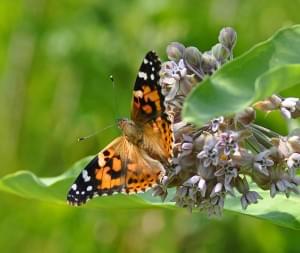My garden has feet of clay. The place my house resides is on an old riverbed. The house was built in 1913. We have pictures of it with a horse and buggy in front of it – the horse has mud splashed up to his chest. The soil, in the places I haven’t worked it, is rock hard. My first shovel into the ground the year we moved in twanged like a banjo string.
Compounding the problem was the former landowners. The Fredrickson family lived on the property for generations and though they kept the original woodwork pretty much intact, their respect for all creatures bright and beautiful was in question. They had a landscaping company come in weekly to trim the juniper bushes and frost the lawn with a fine layer of pesticides, herbicides, and fungicides. “Kill to Control” was their motto.
I saw one butterfly the entire summer of our first year in the house. It landed on the only tulip that was brave enough to bloom that spring. The yard was a desert. It looked tidy, but I found it a terrifying land of death.
I brought compost from our previous home. My husband and I built a lump of greens, coffee grounds, and dry leaves in the side yard under a tree and tossed our red worm collection upon it. We let the chickens turn it with their little rake like feet after it had a chance to get established. From these humble beginnings has risen an army of red wrigglers and earthworms that now till the soil in every corner of my yard. Compost and mulch are my life lines.

The coffee grounds are part of my secret of success. I used to get them from coffee shops. They provided free bags of used grounds in resealed metallic vacuum bags. Coffee grounds are high in nitrogen and easy to compost as they’re already particulate matter. Worms love them.
Most people have heard that coffee grounds are good for roses. This is true if you are going for leaf growth. The extra nitrogen in coffee grounds help leaves stay green and vibrant. Potassium and Phosphorus are the minerals that particularly target flowers and then fruit/seed production. In my experience, coffee grounds as a top dressing are best for my leafy annuals like basil, lettuce, cilantro and parsley. It makes a noticeable difference even a few days after I sprinkle ground on the soil near the roots of my desired greens.
I have a high traffic area near my backdoor that needs extra nitrogen. I also have chickens who run free in the backyard. Reseeding the lawn every year would be silly. Free seeds for the chickens. I solve my dilemma by throwing down coffee grounds onto places when my grass needs a little boost. The chickens won’t eat the grounds so it is free to fertilize the soil. It looks nice and black so I can fool people into thinking the grounds are just dark earth, maybe a little spilled potting soil?
As the shoestring herbalist, I like the cheap factor. Coffee shops give the grounds away for free. I can sprinkle them on the ground knowing it doesn’t hurt my pocketbook or the wildlife I adore. I just shake out the coffee grounds and savor the scent of a rich morning brew.






